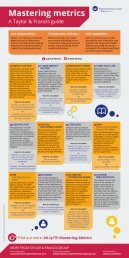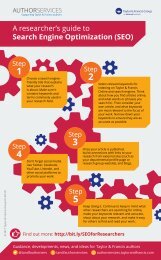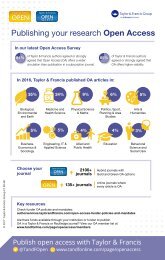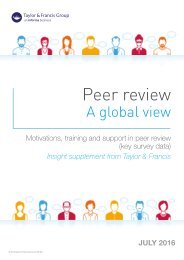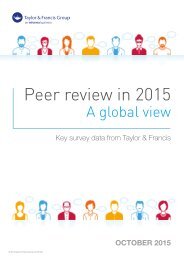White paper
Peer Review in 2015
Peer Review in 2015
Create successful ePaper yourself
Turn your PDF publications into a flip-book with our unique Google optimized e-Paper software.
What am I checking? Structuring reviews<br />
Reviewers find a basic checklist the most beneficial<br />
format for ensuring the quality of the review. The<br />
more highly structured and rigid the review format is,<br />
through structured forms to numerical rating scales,<br />
the less beneficial reviewers find them. However, the<br />
least beneficial of all formats was a totally unstructured<br />
review, suggesting reviewers like some guidance but<br />
not too much.<br />
“Sometimes the amount of feedback received<br />
is very meagre and poor. It is not really true to<br />
say it has been peer reviewed. I want something<br />
that is benchmarked, that has had the<br />
minimum attention we expect when we do peer<br />
review. We need a sufficient quality so that the<br />
person that is reviewed can feel satisfied that<br />
my <strong>paper</strong> might not get in this journal, but the<br />
comments raised by the reviewers are excellent<br />
so that I can revise my <strong>paper</strong> and resubmit<br />
it. Not just to this journal, but maybe to other<br />
journals as well.”<br />
Author, Literature Studies, South Africa<br />
Most beneficial<br />
Despite many publishers creating guides for reviewing,<br />
whether online or in other formats (including Taylor &<br />
Francis), it does not seem, based on the responses<br />
given here, that these are reaching a wide number of<br />
reviewers at the point at which they review. Others<br />
have asked the question whether now is the time for<br />
publisher-wide agreement and guidance on reviewing.<br />
Could this help to ensure that everyone involved in<br />
peer review is fully aware, and comfortable, with the<br />
expectations of their role?<br />
“It would be great if the journal could make<br />
a list of do’s and don’ts, with clear examples.<br />
Give training in how to write a good and useful<br />
review, while minimizing the invested time.<br />
Provide examples of good and bad reviews.<br />
How to politely phrase critique. Explain how<br />
to structure a review, etc. … I think that every<br />
publisher should make such an online guide<br />
available for free, since improving the quality of<br />
the reviews leads to improving the quality of the<br />
publisher’s journals.”<br />
Researcher, Computer Science, Luxembourg<br />
Basic checklist Structured form Numerical rating<br />
scale<br />
Least beneficial<br />
Totally<br />
unstructured<br />
6<br />
What’s the alternative?<br />
Different models of peer review<br />
Authors<br />
(HSS)<br />
Authors<br />
(STM)<br />
Reviewers<br />
(HSS)<br />
Reviewers<br />
(STM)<br />
Editors<br />
(HSS)<br />
Editors<br />
(STM)<br />
1<br />
1 1<br />
1<br />
1<br />
1<br />
1<br />
Uncomfortable<br />
4 or below<br />
SB<br />
4.1<br />
SB<br />
4.0<br />
4.4<br />
PP<br />
SB<br />
4.4<br />
OP<br />
4.7<br />
OP<br />
4.7<br />
4.7<br />
PP<br />
PP<br />
4.9<br />
O<br />
5.1<br />
OP<br />
5.3<br />
5.1<br />
PP<br />
O<br />
5.3<br />
5.1<br />
PP<br />
SB<br />
5.4<br />
OP<br />
5.4<br />
OP<br />
5.4<br />
O<br />
5.7<br />
OP<br />
5.7<br />
5.7<br />
PP<br />
O<br />
5.8<br />
O<br />
6.0<br />
5.9<br />
SB<br />
O<br />
5.9<br />
SB<br />
6.5<br />
Moderately comfortable<br />
5 to 7<br />
DB<br />
8.1<br />
DB<br />
8.0<br />
DB<br />
8.4<br />
DB<br />
8.6<br />
DB<br />
8.9<br />
DB<br />
8.9<br />
Very comfortable<br />
8 or above<br />
10<br />
10<br />
10<br />
10<br />
10<br />
10<br />
1<br />
2<br />
3<br />
4<br />
Definitions of types of peer review<br />
(as given in the online survey and at focus groups)<br />
Single blind (SB): Peer review where only the author’s name is known to the reviewer<br />
but the reviewers’ names are not known to the author<br />
HSS reviewers 7.2 6.7 5.4 4.5<br />
Double blind (DB): Peer review where neither the author’s nor the reviewers’ names<br />
are known to each other<br />
STM reviewers 7.2 7.0 6.3 4.7<br />
Mean scores on a scale of 1 - 10, 1 being the lowest, 10 the highest.<br />
Open (O): Peer review where both the author’s and reviewers’ names are known<br />
to each other<br />
Open and published (OP): Peer review where both the author’s and reviewers’<br />
names are known to each other and the reviewers’ signed reports are openly<br />
published alongside the <strong>paper</strong><br />
Post-publication (PP): Peer review where online readers comment on, or rate the<br />
<strong>paper</strong> following publication<br />
18 PEER REVIEW IN 2015 A GLOBAL VIEW<br />
WHAT’S THE ALTERNATIVE?<br />
19





